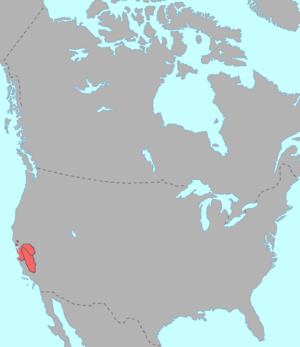Yok-Utian languages facts for kids
Quick facts for kids Yok-Utian |
|
|---|---|
| Geographic distribution: |
California |
| Linguistic classification: | Penutian ?
|
| Subdivisions: | |
 Pre-contact distribution of Yok-Utian languages
|
|
The Yok-Utian language family is a group of languages that some experts believe are related. These languages were spoken in California. This proposed family includes the Yokuts language and the Utian language family.
Contents
What is Yok-Utian?
Scientists who study languages, called linguists, noticed similarities between Yokuts and Utian languages. They tried to figure out their ancient "parent" languages, called proto-languages. This idea started in 1986.
In 1991, a linguist named Geoffrey Gamble officially suggested the name "Yok-Utian." Another expert, Catherine Callaghan, also found evidence for this family. She looked at words, how words are formed, and sounds. She found many similarities between the reconstructed proto-languages. However, even with this strong evidence, experts say it's not 100% proven yet.
Where Did They Come From?
Experts think the original Yok-Utian language was spoken a long time ago. This was around 4500 BC (about 6,500 years ago) in a place called the Great Basin.
Around 2500 BC (about 4,500 years ago), the group split.
- One group, who spoke Proto-Utian, moved from the Great Basin into California.
- Later, between 1000 and 500 BC, Proto-Miwok started to appear. This was in the northern Bay Area. It then spread to the west and south.
- Proto-Costanoan developed in the eastern Bay Area. It split from the larger Utian group after 1500 BC.
- The language that stayed in the Great Basin became Proto-Yokuts. Over time, it split into different Yokuts dialects. These speakers then slowly moved into California.
Some linguists, like Scott DeLancey and Victor Golla, have a different idea. They think that one group of Yok-Utian speakers moved into California. Then, they spread out across the state.
How Do We Know They're Related?
One way experts look for connections is by comparing sounds. They look for "sound correspondences" in the reconstructed proto-languages. This means finding similar sounds that changed in a regular way over time.
Here is an example of some sound similarities:
| Proto-Yokuts | Proto-Utian | English Meaning |
|---|---|---|
| [*waʔin] | [*waja] | "to give" |
| [*ʔatʰ-] | [*ʔat-] | "to split, break" |
Even though these sound similarities are interesting, they don't fully prove the connection. The people who spoke Yokuts and Utian languages lived near each other for hundreds or thousands of years. It's possible that they borrowed words and sounds from each other. This means the similarities might be from sharing, not from a common ancestor language.
Yok-Utian and Penutian
The Yok-Utian idea can fit into a bigger language group called Penutian. However, the Yok-Utian proposal itself doesn't directly prove that Penutian is a real language family.
See also
 In Spanish: Lenguas yokutianas para niños
In Spanish: Lenguas yokutianas para niños

